
Pinhel is a municipality, former Catholic bishopric and present Latin titular see in the central subregion of Beira Interior Norte, in Portugal. The municipality population in 2011 was 9,627, in an area of 484.52 km2. The urban centre of Pinhel had about 3500 residents in 2001.
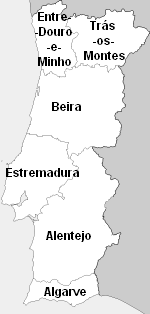
Beira was one of the six traditional provinces or comarcas of Portugal.
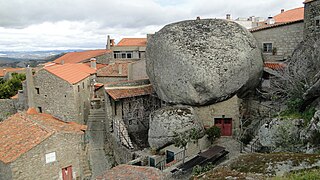
The Central Region or Central Portugal is one of the statistical regions of Portugal. The cities with major administrative status inside this region are Coimbra, Aveiro, Viseu, Caldas da Rainha, Leiria, Castelo Branco, Covilhã, Torres Vedras and Guarda. It is one of the seven Regions of Portugal. It is also one of the regions of Europe, as given by the European Union for statistical and geographical purposes. Its area totals 28,462 km2 (10,989 sq mi). As of 2011, its population totalled 2,327,026 inhabitants, with a population density of 82 inhabitants per square kilometre.

Mogadouro is a municipality in Portugal. The population in 2011 was 9,542, in an area of 760.65 km².

Figueira de Castelo Rodrigo is a municipality in the District of Guarda in Portugal. The population in 2011 was 6,260, in an area of 508.57 km2. Located in the Riba Coa, just like other municipalities around Riba Coa, such as Almeida, Meda, Pinhel and Sabugal. Known for its castle which is a listed National monument, as well as pine-wood forests and rolling hills.
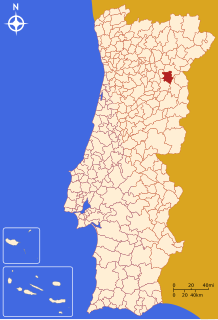
Mêda is a municipality in Portugal. The population in 2011 was 5,202, in an area of 286.05 km2. The city of Mêda proper had a population of 2,004 in 2001. It was promoted to city in December 2004.

Vila Nova de Foz Côa is a city and a municipality in the district of Guarda, Portugal. The population in 2011 was 7,312, in an area of 398.15 square kilometres (153.73 sq mi). The city population is around 3,300. Main rivers in the municipal territory include the Douro and the Côa.

The Côa River is a tributary of the Douro River, in central and northeastern Portugal. It is one of the few Portuguese rivers that flows south to north. It flows through the municipalities of Sabugal, Almeida, Pinhel, Figueira de Castelo Rodrigo and Vila Nova de Foz Côa, all located in the Guarda District.

The Prehistoric Rock-Art Site of the Côa Valley is an open-air Paleolithic archaeological site located in northeastern Portugal, near the border with Spain.
The Protected areas of Portugal are classified under a legal protection statute that allows for the adequate protection and maintenance of biodiversity, while providing services for ecosystem that maintains the natural and geological patrimony.

The Nature Park of Faial, or simply Faial Nature Park (PNF), developed from the intention of better managing the protected areas of the island of Faial, and was instituted by the Secretaria Regional do Ambiente e do Mar of the Autonomous Regional Government of the Azores.

The Castle of Vilar Maior is a well-preserved medieval castle located in the civil parish of Aldeia da Ribeira, Vilar Maior e Badamalos, in the municipality of Sabugal, Guarda district, Portugal.
The Protected Areas of the Azores are the basic administrative-territorial and conservation structures in the archipelago of the Azores and the surrounding oceans. The areas integrate the entirety of the Azores within its Exclusive Economic Zone, as well as the surrounding waters, under the international agreements and conventions. The network realizes the categorization of management for protected areas adopted by the International Union for Conservation of Nature (IUCN), adapting it to the specific geographical, environmental, cultural and political-administrative territory of the archipelago.
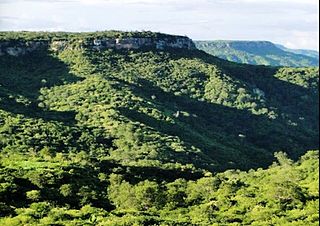
Serra das Almas Private Natural Heritage Reserve is a private natural heritage reserve in the states of Ceará and Piauí, Brazil.
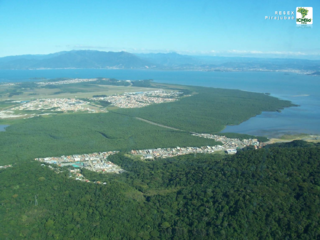
Pirajubaé Marine Extractive Reserve is an extractive reserve in the state of Santa Catarina, Brazil, created in 1993. The purpose was to support sustainable harvesting of shellfish from a shoal in the south bay of the Santa Caterina Island. In recent years, due to various natural and human causes including dredging and over-fishing, the catch has declined steeply. As of early 2016 just three families continued traditional extraction of the shellfish.

The Salto Morato Private Natural Heritage Reserve (Portuguese: Reserva Natural Salto Morato is a private natural heritage reserve in the state of Paraná, Brazil. It protects an area of Atlantic Forest that is home to many endemic bird species.

The Mata Escura Biological Reserve is a biological reserve in the state of Minas Gerais, Brazil. It protects a remnant of Atlantic Forest, and includes a unique mix of vegetation on sandy hilltops. The reserve overlaps with a traditional quilombo community, creating a conflict with the reserve's full-protected status.

















